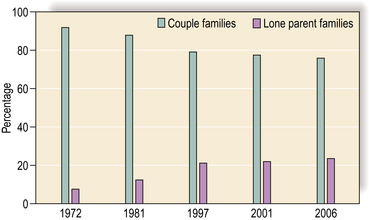Chapter 7 Adulthood and middle age
As young people mature into adults, their health behaviour changes. They may become less likely to take risks when they have responsibilities and may no longer perceive themselves as invincible.
Most children long to be grown up, and grown-ups are seen as having rights and privileges that are strongly desired by children (see pp. 10–11). However, they do not always recognize the accompanying responsibilities of adulthood. Young adults grapple with problems of budgeting, relationships, demands of work and study.
The ages between 17 and 40 years are often described as early adulthood and, until relatively recently, would be regarded as the prime of life. Individuals and society emphasize growth and development on each birthday. In the UK, the 18th birthday is seen as being culturally important. Other important milestones may be the legal age of consent to sexual intercourse, drinking alcohol in pubs or voting. It is also a healthy time of life and young adults are the age group that are least likely to consult doctors apart from health related to reproduction (see pp. 4–5).
Marriage and civil partnerships
During adulthood most people will form a relationship with the opposite sex. Family patterns are rapidly changing. Many couples cohabit, though most (76% of women and 71% of men) expect to marry. In 2006 24% of children were living in one-parent families in the UK (Fig. 1) – more than triple the number from 1972 (Office for National Statistics 2007). Homosexual partnerships are becoming increasingly accepted in our society. Civil partnerships give the same rights to homosexual couples as heterosexual couples. There were over 15 000 civil partnerships between December 2005 and September 2006, 60% of which were male couples.

Fig. 1 Changes in the percentage of children living in one-parent families in the UK between 1972 and 2006
(from Office for National Statistics 2007, with permission).
Stay updated, free articles. Join our Telegram channel

Full access? Get Clinical Tree


